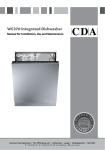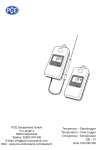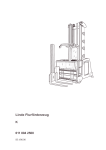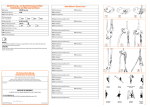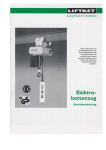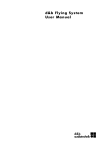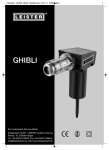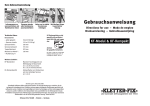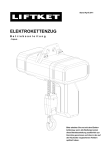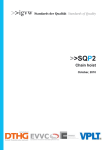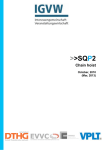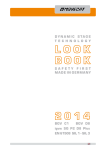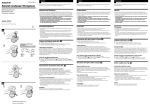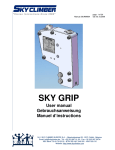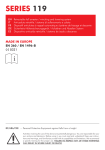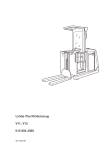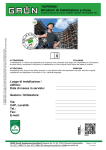Download SQP1 - igvw
Transcript
>>igvw SQ P1 >>igvw Standards der Qualität Standards of Quality >>SQP1 Trusses Oct, 2010 (Mar, 2013) Table of contents 1 >>igvw SQ P1 Legend Notes regarding the structure of the standards: SQ O P Q 1, 2, 3, ... Standard of Quality Organisation Code of practice/working procedure Qualification consecutive numbering O Organisation/Documentation Internal structure of operations and organisation of businesses Documentation and certification of processes P Code of practice/working procedure Supply and use of working materials Q Qualification Qualification of skilled personnel and experts 2 Table of contents >>igvw SQ P1 Preliminary note SQ Standards are intended to define the quality levels required of services provided within the event technology industry. SQ Standards take into consideration current legal positions and on that basis, provide a description of the industry’s specialised working procedures. They contain a summary of the applicable legal standards and requirements in areas of industrial safety and health protection. This Quality Standard has been developed by the responsible working group of the igvw (Entertainment Technology Industry Association) in cooperation with the DGUV (German Social Accident Insurance) and the working group of the safety engineers from the German public broadcasting organisations: ARD, ZDF Medienakademie, ARTE, BR, Bavaria, DR, DW, HR, IRT, MDR, NDR, ORF, RB, RBB, RBT, RTL, SF, SR, Studio Hamburg, SWR, WDR and ZDF. Table of contents 3 >>igvw SQ P1 Notes on use: This pdf file is annotated with interactive links and bookmarks. In the table of contents a mouse click on an item leads straight to the corresponding chapter. At the bottom of each page there is a link that leads back to the table of contents. The links next to the illustrations open up a 3D view (needs Adobe Reader 8.x or newer). An internet connection is required. 4 Table of contents >>igvw SQ P1 Table of contents Preliminary note................................................................................................ 1 Area of application.............................................................................7 2 Normative and informal references....................................................7 3 Definitions.....................................................................................9 4 Supply.........................................................................................11 4.1 Constructional requirements...............................................................11 4.2 Information for users..........................................................................12 4.3 Technical documentation....................................................................13 4.3.1 Technical data.....................................................................................13 4.3.2 Loading capacity.................................................................................13 4.3.3 Static analysis....................................................................................13 4.4 Labelling..........................................................................................14 5 Use...................................................................................................14 5.1 Qualification and responsibility............................................................14 5.2 Choice of trusses................................................................................15 5.3 Installation of trusses..........................................................................15 5.4 Force transmission in trusses............................................................17 5.5 Lifting trusses………...........................................................................17 5.5.1 Equipment for lifting and load suspension.........................................17 5.5.2 Methods of lifting trusses....................................................................18 5.6 Safety precautions during assembly and operation.............................21 6 Inspections....................................................................................22 6.1 Basic principles of inspections............................................................22 6.2 Inspections before use.......................................................................22 6.2.1 Inspections before manufacture .........................................................22 6.2.2 Inspections before entry into service....................................................23 6.3 Inspections during use......................................................................24 6.3.1 Inspections during set-up and operation.............................................24 6.3.2 Regular inspections............................................................................25 6.3.3 Extraordinary inspections..................................................................25 6.4 Documentation............................................................................25 Appendix I Lifting trusses..................................................................................27 II A sample list of contents for a static analysis..................................31 III A sample handover protocol............................................................32 IV Scope of inspection after assembly................................................33 Literature references.......................................................................................34 Table of contents 5 >>igvw SQ P1 The solutions described in this igvw Standard do not rule out the validity of other solutions that guarantee the same standard of safety, as laid down within the technical regulations of other member nations of the European Union or Turkey, or other member states of the European Economic Area. Please note: Wherever possible gender-free nouns and pronouns have been used. Where this is not possible the male noun or pronoun has been used to improve readability, but also is meant to refer to females. 6 Table of contents >>igvw SQ P1 1 Area of application This standard applies to the supply and use of trusses and constructions made from trusses in the setup of productions and events. 2 Normative and informal references BGI 638 edition 1998 Information regarding rope ladders BGI 810 edition 03-2008 Safety at productions and events - guidelines DIN 4113 – 1/A1: 2002-09 Aluminium constructions under predominantly static loading – Part 1: calculations and structural design DIN 4113 – 1/A1 Amendment 1: 2008-12 Aluminium constructions under predominantly static loading – Part 1: calculations and structural design DIN 4113 - 2: 2002-09 Aluminium constructions under predominantly static loading – Part 2: calculations of welded aluminium constructions DIN 4113 - 2 Amendment: 2008-12 Aluminium constructions under predominantly static loading – Part 2: calculations of welded aluminium constructions DIN V 4113 - 3: 2003-11 Aluminium constructions under predominantly static loading – Part 3: design and qualification of manufacturers DIN V 4113 – 3 Amendment: 2008-12 Aluminium constructions under predominantly static loading – Part 3: design and qualification of manufacturers DIN 18800 - 1: 2008-11 Steel structures – Part 1: design and construction DIN 18800 - 2: 2008-11 Steel structures – Part 2: stability – bending of bars and skeletal structures Table of contents 7 >>igvw SQ P1 DIN 18800 - 7: 2008-11 Steel structures – Part 7: design and qualification of manufacturers igvw SQ Q2 Expert in event rigging DIN VDE 0100-540: 2008-01 low voltage electrical installations Parts 5-54: selection and erection of electrical equipment – protective earthing construction, protective earthing conductors 8 Table of contents >>igvw SQ P1 3 Definitions Truss structural element made of metallic material Truss construction a structure made by combining a number of trusses Truss connector component used to connect trusses Truss adapter (Gizmo, Bracket, Loadbar) load-carrying equipment made of metal bars with a suspension point and pipe clamps for connecting trusses and suspension- or load-bearing equipment Chord (chord beam) longitudinal bar of a truss Brace (cross-brace) bar running diagonally, vertically or horizontally Sleeve Block guide block used for moving trusses and truss constructions vertically on towers Tower vertical column Manufacturer maker of products, i.e. the person who buys materials or pre-fabricated elements and makes them into a product Loading capacity the load which a truss can safely carry Truss node joint connecting chord and brace End plate flat steel plate forming the end of a truss Uniformly distributed load (UDL) a load that is spread equally along the length of the truss Table of contents 9 >>igvw SQ P1 Third point positions of two loads placed symmetrically each at one third of the total length Quarter point positions of three loads placed symmetrically each at one quarter of the total length Normal force total internal force acting along the longitudinal axis of a truss or one of its parts (e.g. chord) Shear force total internal force acting laterally on a truss or one of its parts (e.g. chord) Bending moment total internal force which causes bending of a truss or one of its parts (e.g. chord) Single-span girder Truss with two supports Multi-span girder Truss with more than two supports Jib or cantilever Truss which projects beyond a support, thus basically a beam supported at only one end 10 Table of contents >>igvw SQ P1 4 Supply If a contractor is to supply suitable trusses it is necessary during the planning, choosing and purchasing phases to pay particular attention to the intended use, environmental influences, ergonomics, and the qualification and experience of the users. The contractor may only supply trusses that conform to the specifications laid down in Part 4 “Supply” and Part 6 “Inspections”. Only truss connectors and accessories may be used that are approved by the manufacturer. In general this means that only trusses from the same manufacturer may be joined together to form a truss construction. 4.1 Constructional requirements In the construction, structural calculation and production of trusses it is necessary to apply current legal norms, e.g. laws, regulations, work-safety regulations and the current state of technology rules. Since trusses are constructed mainly of aluminium, DIN 4113 - 1, “Aluminium constructions under predominantly static loading – Part 1: static analysis and structural design” and DIN 4113 - 2, “Aluminium constructions under predominantly static loading – Part 2: static analysis of welded aluminium constructions” are of particular importance. When other material are used, the appropriate state of technology rules are to be taken into account, for instance DIN 18800 for trusses made of steel. Companies that carry out welding operations on supporting elements must be properly certified. Note: The loading capacity of a truss depends on the construction, materials used, and production. For the structural calculation of the admissible loading capacity, the appropriate state of technology rules must be applied for all parts of the truss (chords, braces, wall-thicknesses, connectors, welding seams .....). − Aluminium trusses are normally welded constructions made from semifinished products (tubes, plates and bars). The semi-finished products are often made of wrought aluminium alloy which was rolled out warm and which becomes softened under the influence of heat. It is necessary to make allowance for the lower strength of the welding seams and heat affected zones in comparison with the basic material. − When different alloys are welded together the specifications of the less stable material are to be considered relevant. − Allowance must be made for additional bending moments caused by Table of contents 11 >>igvw SQ P1 eccentricity of the centroidal axes of the lattice nodes and other relevant parts. − The joint between two trusses must also be assumed to be the most vulnerable part of the whole construction, because the modular systems can be put together in any combination by the user. − A misalignment of the transmission of force due to end-plates at the joints of individual trusses causes local bending. − Bending moments must be taken into account that can be caused by the application of force or support or suspension outside the framework nodes.. − Documented evidence must be provided about the normal force, bending moment and shear force of the truss connectors. No permanent distortion may occur Note: If trusses are used as a permanent part of physical structures, their construction is governed by building legislation. In such situations only trusses may be used that conform with EU building product guidelines and consequently with German building product laws. Written verification of this must be provided by the manufacturer of the trusses. 4.2 Information for users The contractor may only provide trusses for which the manufacturer supplies a user manual and assembly instructions in German. The following information in particular must be included to ensure proper utilisation: − a definition of the mounting and operating positions − instructions on the correct assembly of the system elements − guidance on set-up, dismantling and operation − instructions on rigging and support (inducing in- and output of forces) − information on the loading capacity of statically indeterminate systems (for instance constructions with more than two supports, or box structures) − information on the loading capacity of jibs − information on the use of trusses as vertical supports − information on which dynamic factors were taken as the basis for the data on loading capacity − information on protective earthing in particular with regard to trusses that are hanging or inserted or that have coated surfaces − instructions on handling, storage and transport − instructions for maintenance (overhauling, servicing, inspections) − information on the carrying out of regular inspections and criteria for removal from service − information on the acquisition of spare parts 12 Table of contents >>igvw SQ P1 4.3 Technical documentation The contractor may only provide trusses for which the manufacturer has supplied, for each type of truss which he manufactures, German-language documentation with all safety-relevant information. The technical documentation must in particular include the following information: 4.3.1 Technical data − a list of all the parts of the truss type − technical drawings − dead weight − materials used in construction − a list of accessories 4.3.2 Loading capacity − maximum uniformly distributed load − maximum point load in midspan − maximum point load at the one-third span points − maximum point load at the one-quarter span points These values are to be given including details of possible combinations of trusses as foreseen by the manufacturer, their installation position, the type of support, suspension and load application. 4.3.3 Static analysis The contractor may only provide trusses for which the manufacturer can supply written evidence in German of a certified static analysis (see section 6.2.1) with specification of the criteria of calculation and the norms used. In addition the following information is also required: − maximum normal force in the chord profiles (max. n) − maximum bending moment (max. m) − maximum shear force (max. s) Table of contents 13 >>igvw SQ P1 4.4 Labelling The following must be permanently and visibly attached to the truss: − manufacturer − month and year of construction (mm/yy) − model type − serial number − dead weight in kg 5 Use Only those trusses may be used that conform with the specifications laid down in section 4 “Supply”. Trusses must be used in accordance with the specifications listed below. “Use” means the operation, transport, storage, maintenance, and inspection of working equipment. 5.1 Qualification and responsibility The job and responsibilities of each participating person must be exactly defined. The operator of a building is in particular responsible for the quality, loading capacity and the condition of the suspension points provided by him within the building and for the load carrying capacity of the floor. He must provide the relevant documentation (e.g. a loading capacity plan). The contractor decides on the qualification required for planning, assembly and operation according to the results of his risk assessment. See also igvw SQ Q2 “competence in event rigging”. 14 Table of contents >>igvw SQ P1 5.2 Choice of trusses A decision on which trusses are suitable must be made on the basis of the following criteria: - the static system (e.g. spans with two supporting points or multiple supporting point constructions) - the width of the span between the supports - main loads (dead weight + payload), static for installation without hoisting equipment - main loads (dead weight + payload), static and if necessary dynamic for installation with hoisting equipment - live loads (e.g. wind or snow) - load distribution (point load, uniform load, area load) - additional loading due to persons working on trusses / truss constructions - additional loading due to measures taken to prevent persons falling ease of handling For types of construction and loading not covered by the user manual, additional static analysis is required (particularly with regard to stability and load carrying capacity). Static analysis should be carried out by persons who have completed a relevant degree course and who can show that they have at least three years experience in construction, static analysis or inspection of event technology equipment. 5.3 Installation of trusses During installation, all set-up and utilisation instructions ensuing from the planning stage must be adhered to. Stability and load-bearing strength must be guaranteed at all times. All constructional elements (trusses, connectors etc.) must be subjected to a visual inspection before assembly begins. If there are any obvious defects, such as deformation or material reduction of main chords and struts, any kind of fissure, slot formation at joints or their mountings and deformation of connectors, these parts may not be used and must be clearly labelled as defective, in order to prevent them being used by mistake at a later time. Trusses must be installed using appropriate tools and in the assembly position planned by the manufacturer. The supervisor in charge of installation approves the truss construction for further use. The handover to other users or the operator should be documented in writing (see Appendix IV Handover Protocol). Table of contents 15 >>igvw SQ P1 Protective earthing for trusses Trusses which in the case of an electrical failure could take on dangerous contact voltages are to be incorporated into a collective protective earthing system. This applies to all elements made from material that conducts electricity, upon which equipment is placed or attached to, or through which wires and cables run, which in the case of an electrical failure could come into contact which metal parts. Connections can be made with belt clamps, pipe clamps, bolted connections, or with special unipolar locked socket connections. The protective earthing system, laid out in radial form, should at a central point be connected to the earth of the mains supply. The minimum wire cross-section must be calculated in accordance with DIN VDE 0100 Part 540. Experience has shown following cross-sections to be reliable - up to 50 m, 16 mm2 Cu (fine stranded copper wire) - up to 100 m, 25 mm2 Cu (fine stranded copper wire). In tower systems with movable parts (“sleeve blocks”) the castors or rollers built into the sleeve block have an insulating effect on the moveable truss construction. Therefore this must be fitted with an additional protective earthing conductor. The effectiveness of the protective measures must be proven. Lightning protection When the topography, type of construction or the installation site are such that lightning could strike easily or have serious consequences, truss constructions must be fitted with an effective lightning protection system. The effectiveness of the protective measures must be proven. If effective lightning protection cannot be guaranteed, the endangered area must be evacuated during a thunderstorm. 16 Table of contents >>igvw SQ P1 5.4 Load transmission in trusses Load transmission means all forms and measures with which the loads that actually occur are either transmitted to a truss or from it to a support or suspension point. The nature and type of load transmission in trusses has a determining influence on the actual loading capacity of the trusses that are being used. Load transmission must take place in accordance with the manufacturer’s instructions. When loads are transmitted, it is important to ensure that they are distributed symmetrically on the chords. Lopsided loading can reduce the loading capacity of the trusses and must be taken into account. When horizontal and vertical forces occur simultaneously, an applicable static analysis must be produced. 5.5 Lifting trusses The type and manner of load transmission determines whether the loading capacity of the truss and the stability of the truss construction are maintained, and may only be done by suitably qualified persons. See igvw SQ Q2 “Competence in event rigging”. 5.5.1 Equipment for lifting and load suspension Lifting and load suspension equipment is used to support trusses or to Lifting and load suspension equipment is used to support trusses or to introduce loads into trusses (See also BGI 810-3 – “Safety at productions and events – loads over persons”) Slings are for instance: − round slings made from synthetic fibre − round slings with a wire rope core − lifting straps − steel ropes (lifting ropes) − steel chains (lifting chains) − shackles − oval suspension devices − quick-connection swivel-nut devices − detachable rope end-joints Load suspension equipment is for instance: − beam clamps − truss adapters (gizmo, bracket, loadbar) Table of contents 17 >>igvw SQ P1 − hanging clamps The manufacturer’s instructions for the correct use of lifting and load suspension equipment must always be followed. When the loading capacity of lifting and load suspension equipment for a particular field of use has not been verified, it may not be loaded with more than 0.5 times the loading capacity specified by the manufacturer. When trusses are put up using synthetic or natural fibre slings, a safety backup of wire rope or lifting chain must be used. To protect trusses it is permissible to use wire rope with a loose plastic casing, provided a visual inspection of the wire rope is still possible. 5.5.2 Methods of lifting trusses When slings are used, the corresponding load lifting factor is determined by the lifting method used. The loading capacities, calculated on the basis of the lifting method, must be halved when persons are underneath the loads. A distinction is drawn between the following lifting methods: - Single Fall – (or Drop, Straight, Stinger) The Single Fall lifting method does not cause a reduction of the sling’s loading capacity Load lifting factor 1.0 Link to the 3D view 18 Table of contents >>igvw SQ P1 - BasketThe Basket lifting method brings about an increase in the loading capacity of the sling. The loading capacity is calculated, by multiplying the clamping angle α of the sling by the corresponding load lifting factor: 0° < α ≤ 12° Load lifting factor 2.0 Link to the 3D view 12° < α ≤ 90° Load lifting factor 1.4 Link to the 3D view 90° < α ≤ 120° Load lifting factor 1.0 Link to the 3D view Table of contents 19 >>igvw SQ P1 - Choke The choke lifting method causes a reduction of the sling’s loading capacity. If one lifting rope is used the reduced loading capacity is calculated by multiplying it by the load lifting factor 0.8. Link to the 3D view If two slings are used, the loading capacity is calculated depending on the clamping angle α of the slings by multiplying it by the corresponding load lifting factor: 0° < α ≤ 12° Load lifting factor 0.8 x 2.0 = 1.6 Link to the 3D view 12° < α ≤ 90° Load lifting factor 0.8 x 1.4 = 1.12 Link to the 3D view 90° < α ≤ 120° Load lifting factor 0.8 x 1.0 = 0.8 20 Link to the 3D view Table of contents >>igvw SQ P1 Lifting methods using clamping angles of α > 120° must be measured individually. In addition to the Basket and Choke methods chord tubes may be wrapped around by the sling without reducing the loading capacity. This wrapping is done to secure the position of straight truss sections. 5.6 Safety precautions during assembly and operation In situations when work with trusses involves risks of injury and health hazards that cannot be eliminated by technical or organisational measures, the contractor must provide suitable personal protective equipment and other aids that employees must use in the intended manner. Technical measures: The use of scaffolding, hydraulic platforms, ladders or rope ladders made of metal. Note: When rope ladders are used during operation their length may not exceed 5 m and when they are provided as a means of emergency escape or rescue they may not exceed 10 m in length (BGI 638: information regarding rope ladders). Longer rope ladders may only be used in connection with personal protective equipment against falls. Rope-assisted ascent and descent: this method may only be used by experienced and qualified persons. Organisational measures: Instruction, restricted access, signs Person-related measures / personal protective equipment (PPE): Safety shoes, gloves, protective headgear, hearing protection, PPE against falls (cf. BGR 198, BGR199 personal protective equipment against falls), fall-arresting equipment in accordance with DIN EN 341 or DIN EN 1496 in combination with a safety harness, abseiling devices. The use of PPE against falls requires particular qualification and ability (see also igvw SQ Q2). Additional loads applied to the truss constructions through use of PPE against falls must be taken into account. Table of contents 21 >>igvw SQ P1 6 Inspections The contractor is obliged to provide safe trusses. In order to ensure that only trusses are put to use that are in a proper condition, an inspection is necessary, not only before they are first put on the market, but also before each one is used for the first time. To ensure that the trusses are safe during set-up and use, they must be inspected within the framework of their operational use. This way possible deficiencies or damage can be detected soon enough to be corrected. Repeated inspections are necessary in order to recognise and correct in due time, deficiencies and damage that can occur during the operation of trusses. After significant modification or an overhaul, an inspection is necessary to check that the truss has been restored to a proper condition. If, as a result of the inspection, doubts arise about the safety of a truss, this truss may not be put into use until the defects have been rectified and a second inspection has shown the truss to be safe. 6.1 Basic principles of inspections The manufacturer of trusses must make inspections on the basis of DIN 4113 Part 1, DIN 4113 Part 2 or DIN 18800 Part 1. 6.2 Inspections before use Each purchase leads to a handing-over to the buyer and is concluded with a formal (commercial or administrative) inspection as to whether the contractual agreement has been complied with, and with a technical inspection and the handing-over of the documentation required from the manufacturer or intermediary. 6.2.1 Inspections before manufacture The contractor may only provide trusses for which the manufacturer can supply the following inspection results and documents: − Manufacturing plant and process DIN V 4113-3 Aluminium constructions under predominantly static loading – Part 3: execution and qualification of constructors and DIN 18800-7 Steel constructions – Part 7: execution and qualification of constructors. 22 Table of contents >>igvw SQ P1 − Construction and manufacturing documentation, in particular functional description, danger and risk assessment, construction and manufacturing documentation and proof of specifications. − static inspection by a certified test centre for equipment and product safety or a certified civil engineering test centre, − compliance with the product documentation, in particular construction and loading capacity, safety features (protective earthing connection) and user manuals. 6.2.2 Inspections before entry into service Before putting a truss into service the contractor must make the necessary inspections. Truss constructions must be inspected by a person who has suitable qualifications. Necessary inspections can be: - completeness, - proof of previous inspections, - declarations of compliance, - labelling, - suitability for the designated operational conditions and environmental influences, - assembly and operating instructions, - manufacturer’s testing instructions and criteria, - static analysis and/or certification, - technical drawings. The contractor makes sure that the results of the inspections carried out before entry into service are documented and kept available. Table of contents 23 >>igvw SQ P1 6.3 Inspections during use The safe status of the truss should be sustained during use. Within the framework of the type of use the contractor carries out risk assessments. In this connection he must determine and evaluate the influences that cause damage, taking into account the different kinds of operating modes, and then devise and implement suitable measures to counteract them. As a result the contractor decides on the type and extent of the inspections - after set-up and dismantling, - after any unusual occurrences, - as well as on the deadlines for recurring inspections - and the qualifications demanded of the person who is commissioned to carry them out. 6.3.1 Inspections during set-up and use During set-up (on-site assembly) and each time before use, the safe condition of the truss must be established through a visual inspection and functionality test (see section 5.3). The visual inspection and functionality test include: a check for external damage or wear - provision for the particular circumstances of the surroundings - protective earthing - lightning protection - the documentation of previous inspections (see 6.4) The qualifications required of the tester depend on the complexity of the truss construction and the risks related to its use. 24 Table of contents >>igvw SQ P1 6.3.2 Regular inspections Trusses and truss constructions are to be inspected according to the type and frequency of their use, so that defects and damage can be detected in proper time. The deadlines for inspection are laid down by the contractor as part of the risk assessment, taking into account - existing information from the manufacturer, - influences which may cause damage, - operative experience, - other information on the latest state of technology. During inspections any defects are assessed and decisions made on further use before the next regular inspection. An inspection every 12 months by an expert has been proved to be ideal. The results of the regular inspections must be documented (see section 6.4). 6.3.3 Extraordinary inspections Extraordinary inspections are necessary in particular: - in the event of damage - after a long period of non-use - after substantial modification of the truss The replacement of parts with ones of the same type is not considered to be a substantial modification. The truss may not be used again until an inspection has proved that safe operation can be guaranteed. 6.4 Documentation The results of all inspections are to be documented and available on-site. For the purpose of depicting the complete history of a truss, it is advisable to keep all inspection documents together in one file. Table of contents 25 >>igvw SQ P1 the documentation must be adequate and can contain the following: declaration of compliance of the manufacturer - inspection instructions and criteria of the manufacturer - confirmation of inspections made by the manufacturer - confirmation of inspections made before entry into service - inspections made after substantial modification - risk assessments upon divergence from established inspection intervals - proof of regular inspections results of re-examinations If the documentation is compiled electronically, suitable quality assurance measures are required. If inspection stickers are used, company regulations must ensure that the complete inspection procedure is made transparent. 26 Table of contents >>igvw SQ P1 Appendix Appendix I – Lifting trusses The general rule is that slinging a truss outside its framework nodes causes local bending strain that can lead to a reduction in the loading capacity. This fact must be taken into account in particular with trusses which have a large profile geometry and a correspondingly large distance between the framework nodes. The lifting gear should be placed as near to the framework nodes as possible. Flexible types of lifting gear, such as round slings, generate vertical and horizontal forces when used as double strands. This can lead to a reduction of the loading capacity of the truss. Flexible lifting gear must be directed in such a way that no bending load is generated on the cross braces. Table of contents 27 >>igvw SQ P1 Illustrations of typical lifting methods: Link to the 3D view Link to the 3D view Link to the 3D view Link to the 3D view Link to the 3D view 28 Table of contents >>igvw SQ P1 Link to the 3D view Link to the 3D view Link to the 3D view Link to the 3D view Table of contents Link to the 3D view 29 >>igvw SQ P1 Infobox: Two-chord trusses may only be lifted by the upper chord. Attention must be paid to their lateral bending behavior. Link to the 3D view Link to the 3D view Link to the 3D view 30 Table of contents >>igvw SQ P1 Appendix II – A sample list of contents for a static analysis 1 Preliminary notes 1.1 Basis for calculation 1.2 Description of the construction 1.3 Construction materials 1.4 Load assumptions 1.5 Lifting dynamics 2 Profile and permitted internal forces 2.1 Profile data truss type X 2.2 Loading capacity truss type X 2.3 Profile data truss type Y 2.4 Loading capacity truss type Y 2.5 Profile data truss type Z 2.6 Loading capacity truss type Z 3 Verification 3.1 Pressure rods between the rope rolls 3.2 Cross members truss type Z – deflection units 3.2.1 Truss type Z for single rope of the load bar 3.2.2 Truss type Z for picking roll on the counterweights 3.2.3 Verification of the U-profiles 3.3 Lighting bridges 3.4 Framework 3.4.1 Verification truss type X rig 3.4.2 Verification truss type Y tower 3.5 Ground contact pressure / foundations 3.6 Lifting equipment 4 Requirements Appendix Computer calculation ground support: Computer calculation bridges: Drawings Table of contents 31 >>igvw SQ P1 Appendix III – A sample handover protocol Declaration concerning the correct construction and readiness for use of trusses manufacturer: place of manufacture: company: address: person responsible: customer: supplier: company: address: person responsible: The supplier herewith declares to the customer that all equipment and materials utilised by him conform with the corresponding regulations and accepted technical standards. He furthermore declares that the complete assembly of the trusses has been carried out in accordance with the corresponding regulations and accepted technical standards and that the truss is handed over to the customer as being ready to use. The required documents and individual certificates are to be enclosed. These include for instance material certificates, static calculations or protocols of necessary inspections which have been carried out. date: __________ signature of supplier:________________ date: __________ signature of customer:_______________ 32 Table of contents >>igvw SQ P1 Appendix IV – Scope of inspection after assembly Inspection on the following basis: plan for set-up and dismantling and plan for operation materials used stability against collapse quality, condition load bearing capacity of the floor / ground and or identification-no. dimensions Table of contents distance between supports ballasting 33 >>igvw SQ P1 Literature references Literaturhinweise BGV C1/GUV C1 Veranstaltungs-und Produktionsstätten für szenische Darstellung BGG/GUV-G 912 Ausgabe 04-2009 Grundsätze für die Prüfung von maschinentechnischer Einrichtungen in Bühnen und Studios BGI 810-3 Ausgabe 03-2007 Sicherheit bei Produktionen und Veranstaltungen – Lasten über Personen BGI 638 Ausgabe 1998 Merkblatt für Seilleitern BGR 198 Ausgabe 04-1998 Einsatz von persöhnlichen Schutzausrüstungen gegen Absturz BGR 199 Ausgabe 04-2004 Einsatz von persöhnlichen Schutzausrüstungen zum Retten aus Höhen und Tiefen BGR 500 Ausgabe 04-2008 Betreiben von Arbeitsmitteln DIN 5688 – 3: 2007-04 Anschlagketten – Teil 3: Einzelglieder, Güteklasse 8 DIN 56950: 2005-04 Veranstaltungstechnik – Maschinentechnische Einrichtungen – Sicherheitstechnische Anforderungen und Prüfung DIN 18000: 2003-04 Modulordnung im Bauwesen DIN 18808: 1994-10 Stahlbauten – Tragwerke aus Hohlprofilen unter vorwiegend ruhender Beanspruchung DIN EN 1496: 2007-01 Persöhnliche Absturzschutzausrüstungen - Rettungshubgeräte 34 Table of contents >>igvw SQ P1 EN 287-1: 2006-05 Prüfung von Schweißern - Schmelzschweißen - Teil 1: Stähle EN 341: 2006-06 Persöhnlicher Arbeitsschutz – Abseilgeräte zum Retten DIN EN 353-2: 2002-09 Persönliche Schutzausrüstung gegen Absturz – Teil 2: Mitlaufende Auffanggeräte einschließlich beweglicher Führung DIN EN 360: 2002-09 Persönliche Schutzausrüstung gegen Absturz – Höhensicherungsgeräte DIN EN 361: 2002-09 Persönliche Schutzausrüstung gegen Absturz – Auffanggurte DIN EN 363: 2008-05 Persönliche Absturzausrüstung gegen – Persönliche Absturzschutzsysteme DIN EN 364: 1993-02 Persönliche Schutzausrüstung gegen Absturz; Prüfverfahren DIN EN 818-4: 2008-12 Kurzgliedrige Rundstahlketten für Hebezeuge - Sicherheit - Teil 4: Anschlagketten - Güteklasse 8 DIN EN 818-6: 2008-12 Kurzgliedrige Rundstahlketten für Hebezeuge - Sicherheit Teil 6: Anschlagketten - Festlegungen zu Informationen über Gebrauch und Instandhaltung, die vom Hersteller zur Verfügung zu stellen sind DIN EN 1492-1: 2009-05 Textile Anschlagmittel - Sicherheit - Teil 1: Flachgewebte Hebebänder aus Chemiefasern für allgemeine Verwendungszwecke DIN EN 1492-2: 2009-05 Textile Anschlagmittel – Sicherheit -Teil 2: Rundschlingen aus Chemiefasern für allgemeine Verwendungszwecke DIN EN 1677 – 1: 2009-03 Einzelteile für Anschlagmittel – Sicherheit – Teil 1: Geschmiedete Einzelteile, Table of contents 35 >>igvw SQ P1 Güteklasse 8 DIN EN 1677 – 4: 2009-03 Einzelteile für Anschlagmittel – Sicherheit – Teil 4: Einzelglieder, Güteklasse 8 DIN EN 1677 – 5: 2009-03 Einzelteile für Anschlagmittel – Sicherheit – Teil 5: Geschmiedete Haken mit Sicherungsklappe, Güteklasse 4 DIN EN 1677 – 6: 2009-03 Einzelteile für Anschlagmittel – Sicherheit – Teil 6: Einzelglieder - Güteklasse 4 DIN EN 10002-1: 2001-12 Metallische Werkstoffe - Zugversuch – Teil 1: Prüfverfahren bei Raumtemperatur DIN EN 13411-1: 2009-02 Endverbindungen für Drahtseile aus Stahldraht – Sicherheit – Teil 1: Kauschen für Anschlagseile aus Stahldrahtseilen DIN EN 13411-2: 2009-02 Endverbindungen für Drahtseile aus Stahldraht – Sicherheit – Teil 2: Spleißen von Seilschlaufen für Anschlagseile DIN EN 13411-3: 2009-02 Endverbindungen für Drahtseile aus Stahldraht – Sicherheit – Teil 3: Pressklemmen und Verpressen DIN EN 13411-4: 2009-02 Endverbindungen für Drahtseile aus Stahldraht – Sicherheit – Teil 4: Vergießen mit Metall und Kunstharz DIN EN 13411-5: 2009-02 Endverbindungen für Drahtseile aus Stahldraht – Sicherheit – Teil 5: Drahtseilklemmen mit U-förmigem Klemmbügel DIN EN 13411-6: 2009-04 Endverbindungen für Drahtseile aus Stahldraht – Sicherheit – Teil 6: Asymmetrische Seilschlösser DIN EN 13411-7: 2009-04 Endverbindungen für Drahtseile aus Stahldraht – Sicherheit – Teil 7: Symmetrische Seilschlösser 36 Table of contents >>igvw SQ P1 DIN EN 13411-8: 2009-04 Endverbindungen für Drahtseile aus Stahldraht – Sicherheit – Teil 8: Stahlfittinge und Verpressungen DIN EN 13414-1: 2009-02 Anschlagseile aus Stahldrahtseilen – Sicherheit – Teil 1: Anschlagseile für allgemeine Hebezwecke DIN EN 13414-2: 2009-02 Anschlagseile aus Stahldrahtseilen – Sicherheit – Teil 2: Vom Hersteller zu liefernde Informationen für Gebrauch und Instandhaltung DIN EN 13414-3: 2009-02 Anschlagseile aus Stahldrahtseilen – Sicherheit – Teil 3: Grummets und Kabelschlag-Anschlagseile DIN EN 13889: 2009-02 Geschmiedete Schäkel für allgemeine Hebezwecke – Gerade und geschweifte Schäkel – Güteklasse 6 – Sicherheit igvw SQ P2 Elektrokettenzüge ISO 10042: 2006-02 Schweißen - Lichtbogenschweißverbindungen an Aluminium und seinen Legierungen - Bewertungsgruppen von Unregelmäßigkeiten Table of contents 37 >>igvw SQ P1 Herausgeber: in Zusammenarbeit mit Informationen unter: www.igvw.org 38 Table of contents






































